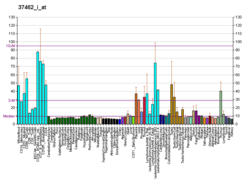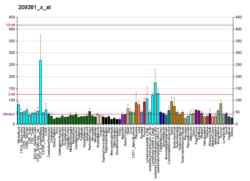SF3A2
Splicing factor 3A subunit 2 is a protein that in humans is encoded by the SF3A2 gene.[3][4][5]
Function
This gene encodes subunit 2 of the splicing factor 3a protein complex. The splicing factor 3a heterotrimer includes subunits 1, 2 and 3 and is necessary for the in vitro conversion of 15S U2 snRNP into an active 17S particle that performs pre-mRNA splicing. Subunit 2 interacts with subunit 1 through its amino-terminus while the single zinc finger domain of subunit 2 plays a role in its binding to the 15S U2 snRNP. Subunit 2 may also function independently of its RNA splicing function as a microtubule-binding protein.[5]
Interactions
SF3A2 has been shown to interact with DDX46.[6]
gollark: You can edit its subjective volume with rightclick.
gollark: ```RUSTU SS UTSUR```
gollark: ~play LyricLy rust tutorial
gollark: ~skip
gollark: ~play here comes science - elements
References
- GRCh38: Ensembl release 89: ENSG00000104897 - Ensembl, May 2017
- "Human PubMed Reference:". National Center for Biotechnology Information, U.S. National Library of Medicine.
- Bennett M, Reed R (October 1993). "Correspondence between a mammalian spliceosome component and an essential yeast splicing factor". Science. 262 (5130): 105–8. doi:10.1126/science.8211113. PMID 8211113.
- Dresser DW, Hacker A, Lovell-Badge R, Guerrier D (September 1995). "The genes for a spliceosome protein (SAP62) and the anti-Müllerian hormone (AMH) are contiguous". Human Molecular Genetics. 4 (9): 1613–8. doi:10.1093/hmg/4.9.1613. PMID 8541848.
- "Entrez Gene: SF3A2 splicing factor 3a, subunit 2, 66kDa".
- Will CL, Urlaub H, Achsel T, Gentzel M, Wilm M, Lührmann R (September 2002). "Characterization of novel SF3b and 17S U2 snRNP proteins, including a human Prp5p homologue and an SF3b DEAD-box protein". The EMBO Journal. 21 (18): 4978–88. doi:10.1093/emboj/cdf480. PMC 126279. PMID 12234937.
Further reading
- Chiara MD, Champion-Arnaud P, Buvoli M, Nadal-Ginard B, Reed R (July 1994). "Specific protein-protein interactions between the essential mammalian spliceosome-associated proteins SAP 61 and SAP 114". Proceedings of the National Academy of Sciences of the United States of America. 91 (14): 6403–7. doi:10.1073/pnas.91.14.6403. PMC 44210. PMID 8022796.
- Rain JC, Tartakoff AM, Krämer A, Legrain P (June 1996). "Essential domains of the PRP21 splicing factor are implicated in the binding to PRP9 and PRP11 proteins and are conserved through evolution". RNA. 2 (6): 535–50. PMC 1369393. PMID 8718683.
- Hong W, Bennett M, Xiao Y, Feld Kramer R, Wang C, Reed R (January 1997). "Association of U2 snRNP with the spliceosomal complex E". Nucleic Acids Research. 25 (2): 354–61. doi:10.1093/nar/25.2.354. PMC 146436. PMID 9016565.
- Moraitou M, Patrinou-Georgoula M, Guialis A (May 1998). "Structural/functional properties of a mammalian multi-component structure containing all major spliceosomal small nuclear ribonucleoprotein particles". The Biochemical Journal. 332 (1): 135–44. doi:10.1042/bj3320135. PMC 1219461. PMID 9576861.
- Yan D, Perriman R, Igel H, Howe KJ, Neville M, Ares M (September 1998). "CUS2, a yeast homolog of human Tat-SF1, rescues function of misfolded U2 through an unusual RNA recognition motif". Molecular and Cellular Biology. 18 (9): 5000–9. doi:10.1128/mcb.18.9.5000. PMC 109085. PMID 9710584.
- Neubauer G, King A, Rappsilber J, Calvio C, Watson M, Ajuh P, Sleeman J, Lamond A, Mann M (September 1998). "Mass spectrometry and EST-database searching allows characterization of the multi-protein spliceosome complex". Nature Genetics. 20 (1): 46–50. doi:10.1038/1700. PMID 9731529.
- Krämer A, Grüter P, Gröning K, Kastner B (June 1999). "Combined biochemical and electron microscopic analyses reveal the architecture of the mammalian U2 snRNP". The Journal of Cell Biology. 145 (7): 1355–68. doi:10.1083/jcb.145.7.1355. PMC 2133165. PMID 10385517.
- Das R, Zhou Z, Reed R (May 2000). "Functional association of U2 snRNP with the ATP-independent spliceosomal complex E". Molecular Cell. 5 (5): 779–87. doi:10.1016/S1097-2765(00)80318-4. PMID 10882114.
- Will CL, Schneider C, MacMillan AM, Katopodis NF, Neubauer G, Wilm M, Lührmann R, Query CC (August 2001). "A novel U2 and U11/U12 snRNP protein that associates with the pre-mRNA branch site". The EMBO Journal. 20 (16): 4536–46. doi:10.1093/emboj/20.16.4536. PMC 125580. PMID 11500380.
- Nesic D, Krämer A (October 2001). "Domains in human splicing factors SF3a60 and SF3a66 required for binding to SF3a120, assembly of the 17S U2 snRNP, and prespliceosome formation". Molecular and Cellular Biology. 21 (19): 6406–17. doi:10.1128/MCB.21.19.6406-6417.2001. PMC 99788. PMID 11533230.
- Dresser DW, Jamin SP, Atkins CJ, Guerrier D (October 2001). "An expressed GNRP-like gene shares a bi-directional promoter with SF3A2 (SAP62) immediately upstream of AMH". Gene. 277 (1–2): 163–73. doi:10.1016/S0378-1119(01)00690-4. PMID 11602354.
- Jurica MS, Licklider LJ, Gygi SR, Grigorieff N, Moore MJ (April 2002). "Purification and characterization of native spliceosomes suitable for three-dimensional structural analysis". RNA. 8 (4): 426–39. doi:10.1017/S1355838202021088. PMC 1370266. PMID 11991638.
- Will CL, Urlaub H, Achsel T, Gentzel M, Wilm M, Lührmann R (September 2002). "Characterization of novel SF3b and 17S U2 snRNP proteins, including a human Prp5p homologue and an SF3b DEAD-box protein". The EMBO Journal. 21 (18): 4978–88. doi:10.1093/emboj/cdf480. PMC 126279. PMID 12234937.
- Takenaka K, Nakagawa H, Miyamoto S, Miki H (August 2004). "The pre-mRNA-splicing factor SF3a66 functions as a microtubule-binding and -bundling protein". The Biochemical Journal. 382 (Pt 1): 223–30. doi:10.1042/BJ20040521. PMC 1133934. PMID 15142036.
- Colland F, Jacq X, Trouplin V, Mougin C, Groizeleau C, Hamburger A, Meil A, Wojcik J, Legrain P, Gauthier JM (July 2004). "Functional proteomics mapping of a human signaling pathway". Genome Research. 14 (7): 1324–32. doi:10.1101/gr.2334104. PMC 442148. PMID 15231748.
- Nesic D, Tanackovic G, Krämer A (September 2004). "A role for Cajal bodies in the final steps of U2 snRNP biogenesis". Journal of Cell Science. 117 (Pt 19): 4423–33. doi:10.1242/jcs.01308. PMID 15316075.
This article is issued from Wikipedia. The text is licensed under Creative Commons - Attribution - Sharealike. Additional terms may apply for the media files.



